Summer 2012, Volume 23
News from the Summer
by Director Ken Sebens
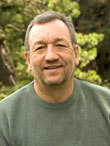 Students and researchers at FHL this summer encountered a few new things when they arrived. First, and largest, was the new flow laboratory. It is barely visible from the water, and fits in nicely with the other labs, having the same roof design and color. Its location was chosen to disrupt the site as little as possible, preserve trees, and be close to the researchers who will be using it. The building was constructed with University of Washington funds, as cost-sharing for a previous NSF grant that outfitted our ocean acidification laboratory (NSF FSML, K. Sebens PI, T. Klinger and J. Murray, Co-PIs), which has now been up and running for over a year. There have already been many projects in the ocean acidification (OA) lab, started by researchers at UW and by visitors. Check out our website in the next few months for a full description of the OA lab and how to use it.
Students and researchers at FHL this summer encountered a few new things when they arrived. First, and largest, was the new flow laboratory. It is barely visible from the water, and fits in nicely with the other labs, having the same roof design and color. Its location was chosen to disrupt the site as little as possible, preserve trees, and be close to the researchers who will be using it. The building was constructed with University of Washington funds, as cost-sharing for a previous NSF grant that outfitted our ocean acidification laboratory (NSF FSML, K. Sebens PI, T. Klinger and J. Murray, Co-PIs), which has now been up and running for over a year. There have already been many projects in the ocean acidification (OA) lab, started by researchers at UW and by visitors. Check out our website in the next few months for a full description of the OA lab and how to use it.
The new flow lab houses a brand new research flume (Rolling Hills Research, mode l 1520) that was installed in June, and has been in heavy use by the biomechanics class this summer (NSF FSML grant, A. Summers PI, E. Carrington Co-PI). It also houses several smaller flumes and a wind tunnel (E. Carrington), as well as an enclosure for photographing and tracking plankton locomotion (D. Grunbaum). This new facility greatly enhances the capacity of researchers at FHL to study the behavior and mechanics of organisms in flow. The new flume is especially useful for measuring forces on large organisms at higher flow speeds. The previous (racetrack) flume, most useful for slow laminar flows over sediments, is now housed under a roof outside, between labs 4 and 5, and is being used by several researchers each year.
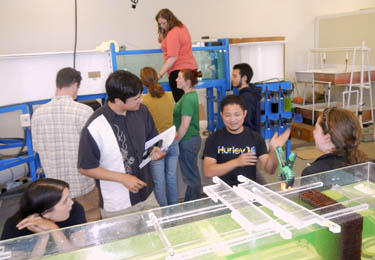 Some of our faculty were pleased to find that we had added another small classroom, in the Fernald la
boratory where the old computer lab had been. This is a nice space that can hold 15 or
so students around a table, with projection facilities. It is easy to darken, which was not true of the main conference room in Fernald. Faculty teaching at FHL have been asking for another small classroom for some time, so this is a welcome addition.
Some of our faculty were pleased to find that we had added another small classroom, in the Fernald la
boratory where the old computer lab had been. This is a nice space that can hold 15 or
so students around a table, with projection facilities. It is easy to darken, which was not true of the main conference room in Fernald. Faculty teaching at FHL have been asking for another small classroom for some time, so this is a welcome addition.
Housing was very tight this summer, so those of you planning to visit next summer should get your requests in early. We had more students than expected in the summer classes, the Blinks and REU programs, and coming to work with visiting faculty. Our response was to double up and add bunk beds to dorm and hut rooms that did not have them before. If this is a trend, we will have to consider other options for the future. Even though we had very good numbers of applicants for summer courses, there were still quite a few students who could not attend because of funding issues, so it is very important that we expand our "Adopt a Student" and other funds that help students come to FHL.

Our FHL Postdoc for the past year, Chris Neufeld, left to take a position at Quest University, British Columbia, Canada. Two other postdocs also left to take faculty positions, Dawn Vaughn (Carrington Lab) to Cal State University, Northridge, and Robin Kodner (FHL/UW Oceanography) just next door at Western Washington University in Bellingham. Given the potential for continuing budget cuts to the university, we are very concerned that the FHL postdoc funding be able to continue, so we have made that a top priority of our fund-raising efforts this year.
Touching Lives
By Laura Long, FHL Advancement Board
On August 21st, Kevin Schofield and I were introduced to our "adoptees" in the Adopt-A-Student program – Maya Groner, a postdoc from the University of Prince Edward Island and Peter Crockett earning his Masters at the University of Melbourne. We enjoyed a relaxed conversation over lunch while enjoying the sun on the dining hall deck. As with all FHL students, Maya and Peter are bright and motivated as well as interesting and engaging to talk with. It was fascinating to find out about the journeys that took them to FHL and to ask what they see for themselves in the future. Read more about Maya and Peter as well as the Adopt-A-Student Program that enabled them to take FHL courses. Read more...
Summer Research for Inspired Undergraduates
Billie J. Swalla, Ph.D.
University of Washington, Professor of Biology
![]() “Welcome to San Juan Island!” An enthusiastic group of summer mentors met the evening ferry early in June to gather a large group of undergraduates who would be spending their summer doing independent research with faculty mentors at Friday Harbor Laboratories. They were a diverse bunch that had travelled from around the USA and they were tired and hungry. We whisked them off to the Bowling Alley for pizza and salad, then took them to FHL and got them settled into the huts, where they would live and work together for the next nine weeks. So began the FHL BEACON/BLINKS/NSF REU Internship program that has been facilitating undergraduate research for the past three summers at FHL. Read more...
“Welcome to San Juan Island!” An enthusiastic group of summer mentors met the evening ferry early in June to gather a large group of undergraduates who would be spending their summer doing independent research with faculty mentors at Friday Harbor Laboratories. They were a diverse bunch that had travelled from around the USA and they were tired and hungry. We whisked them off to the Bowling Alley for pizza and salad, then took them to FHL and got them settled into the huts, where they would live and work together for the next nine weeks. So began the FHL BEACON/BLINKS/NSF REU Internship program that has been facilitating undergraduate research for the past three summers at FHL. Read more...
A New International Program
By Trish Morse, Ph.D.
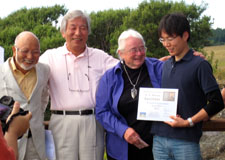 Faculty, graduate students and postdoctoral researchers at Friday Harbor Labs (FHL) have access to a new international program with marine scientists in Japan. The purpose of the program is to exchange scholars between the Friday Harbor Laboratories and several Marine Laboratories in Japan, and to name these marine scientists as life members of the E. S. Morse Institute. Read more about how Makoto Omori, Motonori Hoshi of Japan and Trish Morse of Friday Harbor Labs launched this program in 2012 with four junior and two senior Japanese scholars receiving entry into this program at FHL. Read more...
Faculty, graduate students and postdoctoral researchers at Friday Harbor Labs (FHL) have access to a new international program with marine scientists in Japan. The purpose of the program is to exchange scholars between the Friday Harbor Laboratories and several Marine Laboratories in Japan, and to name these marine scientists as life members of the E. S. Morse Institute. Read more about how Makoto Omori, Motonori Hoshi of Japan and Trish Morse of Friday Harbor Labs launched this program in 2012 with four junior and two senior Japanese scholars receiving entry into this program at FHL. Read more...
NSF Sponsored Ecology of Infectious Marine Disease Course
Ecology of Infectious Marine Disease was taught for a second time at the Labs this summer. The course's success in 2010, allowed us to provide NSF scholarships to graduate students from around the country, associated with a new Research Coordination Network grant in Evaluating the impacts of a changing ocean on management and ecology of infectious marine disease awarded to Dr. Catherine (Drew) Harvell, Dr. Carolyn Friedman and colleagues. This course was also a collaboration with SAFS, through the involvement of two faculty, Dr. Carolyn Friedman and Dr. Steven Roberts and the loan of important molecular equipment. Read more...
E. S. Morse Scholars Investigate Mitigation Of Harmful Algal Blooms
By Vera Trainer, Ph.D.
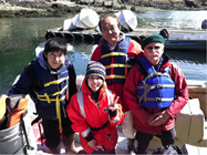 Bacteria associated with eelgrass (Zostera marina) in certain coastal areas of Japan have been shown to inhibit or prevent the growth of harmful algal species. These bacteria may serve as a potential tool for the mitigation of harmful algal blooms (HABs). This work was spearheaded in the laboratory of Professor Ichiro Imai at the Hokkaido University in Japan. In the summer of 2012, Professor Imai and two of his students, Yuka Onishi and Nobuharu Inaba, came to the Friday Harbor Labs to isolate and characterize potential algicidal bacteria from Z. marina collected from the San Juan Islands as well as other areas of Puget Sound. This work was made possible through collaborations with our local seagrass expert, Dr. Sandy Wyllie-Echeverria (Friday Harbor Labs), and our visiting HAB researcher, Dr. Vera Trainer (NOAA Northwest Fisheries Science Center). Return to top of page
Bacteria associated with eelgrass (Zostera marina) in certain coastal areas of Japan have been shown to inhibit or prevent the growth of harmful algal species. These bacteria may serve as a potential tool for the mitigation of harmful algal blooms (HABs). This work was spearheaded in the laboratory of Professor Ichiro Imai at the Hokkaido University in Japan. In the summer of 2012, Professor Imai and two of his students, Yuka Onishi and Nobuharu Inaba, came to the Friday Harbor Labs to isolate and characterize potential algicidal bacteria from Z. marina collected from the San Juan Islands as well as other areas of Puget Sound. This work was made possible through collaborations with our local seagrass expert, Dr. Sandy Wyllie-Echeverria (Friday Harbor Labs), and our visiting HAB researcher, Dr. Vera Trainer (NOAA Northwest Fisheries Science Center). Return to top of page
Collaborative Effort to Identify Disease in Zostera Marina Populations from the San Juan Archipelago
By Sandy Wyllie-Echeverria, Ph.D.
In spring 2010, Drs. Sandy Wyllie-Echeverria of Friday Harbor Labs (FHL) and Joe Gaydos of the SeaDoc Society teamed with Dr. Anne Boettcher and Dan Martin, University of South Alabama, to learn if the slime mold-like microorganism Labyrinthula sp., known to infect the leaves of the seagrass Zostera marina (eelgrass), could be the causative agent of Z. marina declines at some sites in the San Juan Archipelago. They confirmed that the most virulent form of the microorganism was present at research sites where Z. marina was in decline as well as where it was not. Following this and with the aid of Beach Watcher Volunteer and retired microbiologist, Ann Jarrell, single cells of Labyrinthula were cultured in the Seagrass Lab, FHL in a controlled environment. Then healthy leaves were infected with Labyrinthula, the rate of leaf infection was tracked and the influence of the infection on leaf growth and physiological health was measured. Experiments demonstrated that infection compromised both leaf growth and physiological health. Return to top of page
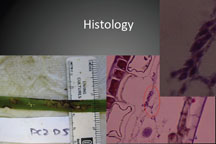 This summer we teamed with Dr. Drew Harvell, a specialist in marine diseases from Cornell University. Dr. Harvell is working to expand our understanding of how and why Labyrinthula causes disease in eelgrass. Dr. Harvell co-teaches a class in marine disease at FHL every other summer with Drs. Carolyn Friedman and Steven Roberts and this summer her class mapped size-specific patterns of disease infection and ecological conditions in different populations that the FHL/SeaDocs team has been monitoring. The class also worked to develop histological and PCR tests associated with the Labyrinthula lesions. The photos below shows Labyrinthula cells in an infected leaf. This research will ultimately help us understand that Labyrinthula causes disease in eelgrass and what we can do to minimize outbreaks.
(Photo Credit: Catherine JS Kim, Cornell University) Return to top of page
This summer we teamed with Dr. Drew Harvell, a specialist in marine diseases from Cornell University. Dr. Harvell is working to expand our understanding of how and why Labyrinthula causes disease in eelgrass. Dr. Harvell co-teaches a class in marine disease at FHL every other summer with Drs. Carolyn Friedman and Steven Roberts and this summer her class mapped size-specific patterns of disease infection and ecological conditions in different populations that the FHL/SeaDocs team has been monitoring. The class also worked to develop histological and PCR tests associated with the Labyrinthula lesions. The photos below shows Labyrinthula cells in an infected leaf. This research will ultimately help us understand that Labyrinthula causes disease in eelgrass and what we can do to minimize outbreaks.
(Photo Credit: Catherine JS Kim, Cornell University) Return to top of page
FHL Science Outreach in Friday Harbor Schools (FHLSOP)
Jenny Roberts, Director, K-12 Program
Friday Harbor Labs Science Outreach Friday Harbor Labs Science Outreach Program is pleased to announce the successful completion of its eleventh year of bringing exciting, hands-on, inquiry-based and relevant environmental science into San Juan Island Schools: Friday Harbor Elementary School (FHES), Friday Harbor Middle School (FHMS) and Spring Street International School (SSIS). During this busy spring season, local students participated in the following engaging projects in the field, lab, and classroom and on the University of Washington's Research Vessel Centennial. Read more...
Tribute to John Blinks: The Right Man for the Place and Time
by Dennis Willows
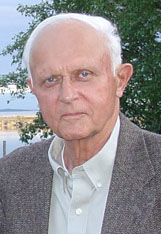
In the early 1960's, although people in biomedical science were beginning to make sense of the roles of DNA, RNA and protein in building and controlling all living creatures, there was still mystery about how muscle contracted. John Blinks recognized then, anlong with others in the field, that calcium ions were on the short list of suspects to be controlling the process. Read More...
FHL is a Priority in my Life
by Jennifer Burnaford, Ph.D.
Jennifer first came to Friday Harbor Labs in the summer of 1995 right after she started graduate school at Oregon State University. Jennifer describes how significant that summer experience was to her teaching and research career and how she has returned to FHL to conduct research each summer since starting her first faculty position in 2003. Now Jennifer is an assistant professor at California State University Fullerton teaching, among other things, Marine Botany. She still has her notes and a lab notebook form that first summer class, and refers to them every time she teaches. She has been a Blinks program mentor five times at FHL and brings students from her home university with her to FHL. Read More...
Mapping the Sea Floor associated with San Juan National Historical Park
by Sandy Wyllie-Echeverria, Ph.D
In response to the U.S. National Parks Service’s interest to understand aquatic processes within the boundaries of San Juan Island National Historical Park (SJINHP), Drs. H.G. Greene and S. Wyllie-Echeverria using the combined techniques of multibeamechosounder (MBES) bathymetry and backscatter data, terrestrial LiDAR aerial photography and underwater videography produced a series of maps illustrating various features of the submerged land associated with SJINHP. Read More...
Ocean Acidification Measurements in San Juan Channel and Suggestions for Mitigation of Causes
by Constance Sullivan, Master's Candidate
Ocean acidification refers to the decline in seawater pH over time due to anthropogenic influences. The primary cause of this condition is the addition of CO2 to the atmosphere from combustion of fossil fuels and other human activities. In coastal areas, other factors can add to the ocean acidification signal, for example through intrusion of upwelled waters or addition of acidic industrial waste products to atmosphere or ocean. The problem of ocean acidification has received substantial attention from the scientific community over the past several years, and our understanding of the problem and its consequences is growing. Despite this, relatively little is known of the acidification condition of coastal waters and their variability over time. To begin to address this need in the San Juan Archipelago, we conducted a study of carbonate chemistry and ocean acidification conditions in the San Juan Channel. Read More...
Nitrogen-Driven Interactions in Rocky Shore Seaweed-Microbe Interactions
by Orissa Moulton, Ph.D. Candidate
Orissa's PhD research explores indirect interactions among marine rocky intertidal organisms via the nitrogen cycle, a limiting nutrient for productivity. Her work will provide insight into nitrogen-based ecosystem services provided by animal communities. Read More...
Profile
Anne Hof Blinks Fellowships Endowment
Trish Morse, Ph.D.
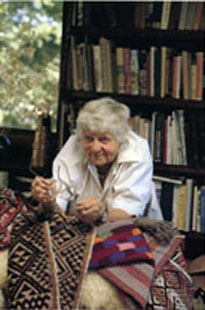
Continuing our series on the lives of named Friday Harbor Labs endowments, Trish Morse talked with Anne Hof Blinks' granddaughter, Sally Shapiro, to tell us about this talented scientist, weaver, and historian. Marine biology runs deep in the Blinks family. Anne Hof Blinks had graduate training in marine biology at Harvard. There she met and married another marine biologist, Lawrence Blinks, moved to California with their son John, where Lawrence became professor of marine biology and head of the Hopkins Marine Station of Stanford University. Anne continued her studies on marine algae, alongside her husband at Hopkins. Carrying on his family's tradition, her son John spent summers and his retirement years at the Friday Harbor Labs where his work on the jellyfish is legendary! Read more about this woman of diverse talents who was honored by her son and daughter-in-law, John and Doris Blinks, with establishment of the Anne Hof Blinks Fellowships Endowment. Read more...
Also of Interest
Friday the 13th at the Pump House

Friday, July 13th at FHL sounded like the score of Mussorgsky's Night on Bald Mountain! Two conflicting weather fronts produced wild thunder and lightning and electrical service was out for a number of hours. Emily Carrington looked at this photo taken by Joe Walkowicz, a student in the Inverts and Biomechanics classes, and said, "Well, this is surely why multiplexer B went down at the pump house. Luckily most of the temperature sensors were on plexer A but B is now replaced and happily logging away, thanks to Ryan McLaughlin."

A Winner!
Laura Newcomb won first place among women in the 8.8 km Friday Harbor Loop Run, around Pear Point and ending at the San Juan County Fair on Saturday August 18 2012. Laura is a graduate student in the Department of Biology at the University of Washington, and is an Integrative Graduate Education and Research Traineeship (IGERT) program fellow, working in Emily Carrington's lab at FHL. Congratulations Laura!
We are also interested in receiving your news and in hearing from "our alums". If you have news items you wish to share with the extended FHL community, please send them to fhlnews@uw.edu.

